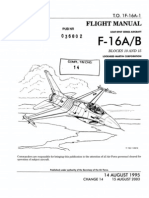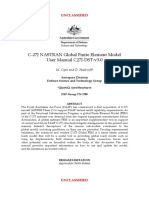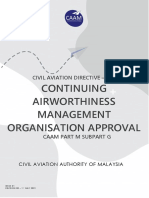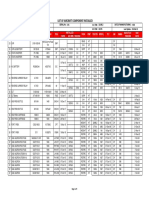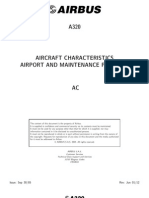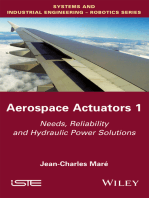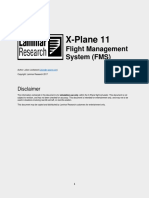Chapter 16 - Landing Gear: REV 3, May 03/05
Chapter 16 - Landing Gear: REV 3, May 03/05
Uploaded by
Anish ShakyaCopyright:
Available Formats
Chapter 16 - Landing Gear: REV 3, May 03/05
Chapter 16 - Landing Gear: REV 3, May 03/05
Uploaded by
Anish ShakyaOriginal Description:
Original Title
Copyright
Available Formats
Share this document
Did you find this document useful?
Is this content inappropriate?
Copyright:
Available Formats
Chapter 16 - Landing Gear: REV 3, May 03/05
Chapter 16 - Landing Gear: REV 3, May 03/05
Uploaded by
Anish ShakyaCopyright:
Available Formats
Vol.
1 16--00--1
LANDING GEAR
Table of Contents REV 3, May 03/05
CHAPTER 16 --- LANDING GEAR
Page
TABLE OF CONTENTS 16--00--1
Table of Contents 16--00--1
INTRODUCTION 16--10--1
Introduction 16--10--1
NOSE AND MAIN LANDING GEAR 16--20--1
Nose and Main Landing Gear 16--20--1
Landing Gear Retraction 16--20--5
Landing Gear Extension 16--20--5
Alternate Landing Gear Extension 16--20--8
Wheels and Tires 16--20--8
Landing Gear Doors 16--20--8
PROXIMITY SENSING SYSTEM 16--30--1
Proximity Sensing System 16--30--1
System Circuit Breakers 16--30--5
BRAKE SYSTEM 16--40--1
Brake System 16--40--1
Parking Brake 16--40--4
Brake Temperature Monitoring System 16--40--6
Anti-Skid System 16--40--8
System Circuit Breakers 16--40--11
NOSE WHEEL STEERING SYSTEM 16--50--1
Nose Wheel Steering System 16--50--1
System Circuit Breakers 16--50--4
LIST OF ILLUSTRATIONS
INTRODUCTION
Figure 16--10--1 Landing Gear Assemblies 16--10--1
MAIN AND NOSE LANDING GEAR
Figure 16--20--1 Main Landing Gear 16--20--2
Figure 16--20--2 Nose Landing Gear 16--20--3
Figure 16--20--3 Landing Gear Retraction and Extension -- Schematic 16--20--4
Figure 16--20--4 Landing Gear Controls 16--20--6
Figure 16--20--5 Landing Gear EICAS Indications 16--20--7
Flight Crew Operating Manual
CSP C--013--067
Vol. 1 16--00--2
LANDING GEAR
REV 3, May 03/05
Table of Contents
PROXIMITY SENSING SYSTEM
Figure 16--30--1 Proximity Sensing System -- Schematic 16--30--2
Figure 16--30--2 Landing Gear Position Indicator 16--30--3
Figure 16--30--3 Proximity Sensing System EICAS Indications 16--30--4
BRAKE SYSTEM
Figure 16--40--1 Brake System -- Schematic 16--40--2
Figure 16--40--2 Brake System EICAS Indications 16--40--3
Figure 16--40--3 Parking Brake Controls 16--40--4
Figure 16--40--4 Parking Brake EICAS Indications 16--40--5
Figure 16--40--5 BTMS Controls 16--40--6
Figure 16--40--6 BTMS EICAS Indications 16--40--7
Figure 16--40--7 Anti--Skid System Controls 16--40--9
Figure 16--40--8 Anti--Skid System EICAS Indications 16--40--10
NOSE WHEEL STEERING SYSTEM
Figure 16--50--1 Nose Wheel Steering System -- Schematic 16--50--2
Figure 16--50--2 Nose Wheel Steering EICAS Indications 16--50--3
Flight Crew Operating Manual
CSP C--013--067
Vol. 1 16--10--1
LANDING GEAR
Introduction REV 3, May 03/05
1. INTRODUCTION
The landing gear is a retractable tricycle type consisting of two wing root mounted main
landing gear assemblies and a forward fuselage mounted steerable nose landing gear
assembly. Each gear assembly has two wheels. The main landing gear assemblies retract
inboard and the nose landing gear assembly retracts forward. Each landing gear has a
shock strut to absorb and dissipate the shock loads encountered when the aircraft lands.
The main landing gear are fitted with steel multi-disc brakes.
Landing gear extension and retraction is electrically activated by the landing gear selector
lever and controlled by the proximity sensing electronic unit (PSEU). Sensors for the PSEU
are mounted on the landing gear and landing gear doors. The PSEU also provides landing
gear position indication on the EICAS display. The landing gear is hydraulically actuated by
hydraulic system 3, in normal operation. An alternate independent means of extending the
landing gear is available should the normal extension system fail.
A tail bumper protects the aircraft tail structure from tail strikes caused by over-rotation of the
aircraft on take-off. The tail bumper consists of a shock absorber, a skid assembly and a
strike indicator.
AFT
DOOR
MAIN
GEAR GEAR
BAYS DOOR
FORWARD
DOORS NOSE
LANDING
GEAR
MAIN
GEAR
DOOR
MAIN
LANDING
GEAR
TAIL BUMPER
Landing Gear Assemblies
Figure 16---10---1
Flight Crew Operating Manual
CSP C--013--067
Vol. 1 16--10--2
LANDING GEAR
Sep 09/02
Introduction
THIS PAGE INTENTIONALLY LEFT BLANK
Flight Crew Operating Manual
CSP C--013--067
Vol. 1 16--20--1
LANDING GEAR
Nose and Main Landing Gear REV 3, May 03/05
1. NOSE AND MAIN LANDING GEAR
Normal extension or retraction of the landing gear is initiated by landing gear control handle
selection. The retraction or extension signal is sent to the proximity sensing electronic unit
(PSEU) which monitors various landing gear proximity sensing inputs and weight-on-wheels
inputs. If the correct parameters are met, the PSEU energizes a selector valve to retract or
extend the landing gear using hydraulic system No. 3 pressure.
The landing gear control handle is equipped with a solenoid lock which prevents an up
selection of the landing gear control handle with the aircraft on the ground. In the event of a
solenoid lock malfunction, a downlock release on the landing gear control panel, permits up
selection of the landing gear control handle by overriding the solenoid lock.
Retraction and extension of each landing gear is driven by a retract/extend actuator. An
auxiliary actuator, powered by hydraulic system No. 2 provides a backup means of
extending the main landing gear.
Tension springs assisted by a downlock actuator ensure that the main gear locks in the
down position. The lock is released at the start of the retraction cycle. An uplock assembly
locks the main gear in the retracted position. An uplock release actuator releases the uplock
assembly at the start of the extension cycle.
The nose landing gear locks in both the extended or retracted positions with a
spring-loaded, over-centre type locking mechanism. A lock actuator moves the locking
mechanism out of the over-center condition at the beginning of each cycle.
Flight Crew Operating Manual
CSP C--013--067
Vol. 1 16--20--2
LANDING GEAR
REV 3, May 03/05
Nose and Main Landing Gear
MAIN LANDING GEAR
UPLOCK ASSEMBLY
RETRACT
ACTUATOR
AUXILIARY
ACTUATOR
MAIN LANDING GEAR SHOCK STRUT
WHEEL BIN ASSEMBLY
LOCK ACTUATOR
DOWNLOCK
MECHANISM
MAIN LANDING
GEAR DOOR
SHIMMY DAMPER
NOTE
Outboard tire removed for clarity.
Brake assembly not shown.
TORQUE
LINK ASSEMBLY
Main Landing Gear
Figure 16---20---1
Flight Crew Operating Manual
CSP C--013--067
Vol. 1 16--20--3
LANDING GEAR
Nose and Main Landing Gear REV 3, May 03/05
RETRACT
ACTUATOR
LOCK
ACTUATOR
SPIN DOWN
ASSEMBLY
DRAG
BRACE AFT
DOOR
FORWARD
DOOR TORQUE
LINK
ASSY
STEERING
ACTUATOR
FORWARD
DOOR SHOCK STRUT
ASSEMBLY
Nose Landing Gear
Figure 16---20---2
Flight Crew Operating Manual
CSP C--013--067
Vol. 1 16--20--4
LANDING GEAR
REV 3, May 03/05
Nose and Main Landing Gear
NO.2 HYDRAULIC
NO.2 HYDRAULIC SYSTEM
SYSTEM
ACCUMULATOR
LANDING GEAR
PSEU EICAS
SELECTOR VALVE
ACCUMULATOR
LANDING GEAR RETURN
BYPASS VALVE
LH MAIN GEAR RH MAIN GEAR
NLG RETRACT
RETRACT RETRACT
ACTUATOR ACTUATOR ACTUATOR
NLG LOCK LH MAIN GEAR RH MAIN GEAR
ACTUATOR UPLOCK UPLOCK
DOWNLOCK
ASSIT LH MAIN GEAR RH MAIN GEAR
VALVE LOCK ACTUATOR LOCK ACTUATOR
NLG MANUAL LH MAIN GEAR RH MAIN GEAR
RELEASE AUXILIARY AUXILIARY
ACTUATOR ACTUATOR ACTUATOR
LANDING GEAR
MANUAL RELEASE
HANDLE
Landing Gear Retraction and Extension --- Schematic
Figure 16---20---3
Flight Crew Operating Manual
CSP C--013--067
Vol. 1 16--20--5
LANDING GEAR
Nose and Main Landing Gear REV 3, May 03/05
For landing gear retraction:
Once the aircraft is airborne, with no weight-on-wheels signal, the PSEU commands
and monitors the following events:
S The landing gear control handle solenoid downlock is released to permit UP
selection of the landing gear control handle.
S The landing gear selector valve energizes the nose and main landing gear
retract/extend actuators, releases the downlocks and retracts the landing gear.
Hydraulic pressure from the landing gear up line is routed to activate the brake
control valves to stop main wheel rotation. The tire spin--down assembly in the nose
landing gear bay stops nose wheel rotation.
S Uplocks are engaged to secure the landing gears in the retracted position.
For landing gear extension:
The PSEU commands and monitors the following events:
S The landing gear control handle is manually selected to the DN position.
S The landing gear selector valve energizes the nose and main landing gear
retract/extend actuators, releases the uplocks and extends the landing gear.
S Downlocks are engaged to secure the landing gear in the extended position.
To prevent the landing gear from retracting when the aircraft is on the ground, ground lock
pins are inserted by the ground crew.
Flight Crew Operating Manual
CSP C--013--067
Vol. 1 16--20--6
LANDING GEAR
REV 3, May 03/05
Nose and Main Landing Gear
Landing Gear Lever Down Lock
Prevents inadvertent landing gear up
selection when on ground.
When airborne, a weight--off--wheels signal
from the PSEU disengages the lock to
permit a gear up selection.
Landing Gear Lever
Used to retract and extend landing gear.
Landing Gear Control Panel
Centre Instrument Panel
DN LCK REL
Used to manually release the landing gear
lever down lock.
NOTE
Considerable force is required to operate the
landing gear manual release system.
Landing Gear Controls
Figure 16---20---4
Flight Crew Operating Manual
CSP C--013--067
Vol. 1 16--20--7
LANDING GEAR
Nose and Main Landing Gear REV 3, May 03/05
NOSE DOOR OPEN warning (red)
Indicates that either nose landing gear
door is not closed after gear is up.
NOSE
DOOR
GEAR DISAGREE warning (red)
Indicates that landing gear position does not
agree with landing gear control handle position.
GEAR
DISAGREE
Primary Page
L or R MLG FAULT status (white)
Indicates that left or right actuator shuttle
valve or the pressure switch have failed in
the closed position (for MLG downlocked)
OR
Left or right actuator pressure switch has
failed in open position (for MLG uplocked).
HORN MUTED status (white)
Indicates that landing gear warning
horn has been manually muted.
Status Page
Landing Gear EICAS Indications <1001>
Figure 16---20---5
Flight Crew Operating Manual
CSP C--013--067
Vol. 1 16--20--8
LANDING GEAR
REV 3, May 03/05
Nose and Main Landing Gear
A. Alternate Landing Gear Extension
If a failure occurs in the landing gear control system or in hydraulic system No. 3, the
landing gear can still be extended by pulling the landing gear manual release handle.
When the manual release handle is pulled, the main landing gear uplocks are released
by mechanical means, and at the same time a bypass valve dumps hydraulic system
No. 3 pressure from the normal extension and retraction hydraulic circuits. This will
permit the landing gear to partially extend under its own weight. The manual release
handle also positions a downlock assist valve to direct hydraulic system No. 2 pressure
to the main landing gear auxiliary actuators and to the nose gear uplock manual
release actuator.
The main landing gear is assisted to the down-and-locked position by the main gear
auxiliary actuators and the nose landing gear is assisted to the down-and-locked
position by airflow and two tension springs.
B. Wheels and Tires
Each wheel has a pressure relief plug (overpressure valve) and an inflation valve.
Refer to the Aircraft Maintenance Manual for tire pressure adjustment.
Four heat sensitive fusible plugs are installed in each main wheel to release excessive
air pressure caused by heat build--up. The fusible plugs protect the main wheel against
tire burst that could occur under heavy braking activity.
C. Landing Gear Doors
The landing gear doors are mechanically linked to the landing gear. The doors close
when the gear retracts and open when the gear extends.
Flight Crew Operating Manual
CSP C--013--067
Vol. 1 16--30--1
LANDING GEAR
Proximity Sensing System Sep 09/02
1. PROXIMITY SENSING SYSTEM
The proximity sensor system (PSS) includes the proximity sensor electronics unit (PSEU)
and associated proximity sensors and proximity switches installed throughout the aircraft.
The PSS provides five basic functions:
S Normal landing gear positioning control
The PSS provides the signals that command the landing gear extend and retract
solenoids to change the position of the landing gear.
S Landing gear position indication
The PSS monitors landing gear position and provides indication of the position status of
the landing gear.
S Weight-on-wheels indication
The PSS monitors landing gear strut compression and provides indication of air or ground
status of the aircraft.
S Fuselage door indication
The PSS monitors fuselage door position, latches and lock status and provides indication
of the status of the doors (refer to Chapter 6).
S Thrust reverser indication
The PSS monitors and reports to EICAS the stowed/unstowed status of the left and right
thrust reversers (refer to Chapter 20).
The PSEU, after processing sensor inputs, generates outputs that are used to control
landing gear position, report status and provide control data for other systems.
Continuous and periodic tests are performed by the PSEU to monitor specific aircraft
systems health and status. Landing gear position and status are displayed on the engine
indication and crew alerting system (EICAS) primary page. The landing gear position
indication is removed 30 seconds after the landing gear is in the up and locked position with
the flaps at 0 degrees.
Flight Crew Operating Manual
CSP C--013--067
Vol. 1 16--30--2
LANDING GEAR
REV 3, May 03/05
Proximity Sensing System
INPUTS OUTPUTS
DATA
PROXIMITY STALL WARNING
SENSORS FLAPS/SLATS SYS/AOA
POSITION FIDEEX
INBD GROUND HORIZ STAB TRIM
SPOILER STOWED CONTROL UNIT 1,2 FADEC L/R
CABIN PRESSURE
OUTBD GROUND FLAP ELECTRONIC NOSE WHEEL
SPOILER STOWED CONTROL UNIT 1,2 STEERING:
PARK BRAKE ON
PARK BRAKE DOWN LOCK
HYDRAULIC MOTOR
SOV CLOSED WOW 1,2
THRUST LEVERS PUMPS
MAIN LANDING POSITION CABIN PRESSURE
GEAR: ANTI SKID
CONTROLLER
WOW 1,2 P INBD/OUTBD
LANDING GEAR AVIONICS
DOWNLOCK 1,2 R STALL PROTECTION
COMMANDS: COOLING SYS
UPLOCK O SYSTEM
EXTEND
RETRACT X CLOCK
NOSE GEAR: I AIR DATA SENSOR
WOW 1,2 M HEATER CONTROL UNIT GEAR HANDLE
NOSE GEAR
DOWLOCK 1,2 I DOWNLINK
DOOR OPENED FUEL SYSTEM
UPLOCK T
OLEO EXTEND COMPUTER UNIT SIGNS:
Y
HORN MUTE AUXILIARY POWER NO SMOKING
NOSE DOOR: ON UNIT (ECU, FIRE) FASTEN
S
L/R CLOSED SEAT BELT
E
UPLOCK THRUST REVERSER
N NOSE GEAR
S 1,2
PAX DOOR: SOLENOIDS:
PIN 1,2 LOCKED O AIR DRIVEN EXTEND
CAM 1,2 LOCKED R GENERATOR RETRACT
HANDLE LOCKED: AUTO DEPLOY
DOOR CLOSED: PAX DOOR E MAIN LANDING
SERVICE/EMERG UTILITY BUS GEAR
COCKPIT EMERG L
BAGGAGE SHED SOLENOIDS:
HATCH E
AFT EQPT COMPARTMENTS C EXTEND
AVIONICS BAY IRS SYS RETRACT
BAY DOOR T
OVERWING R
ATTITUDE HEADING DOOR SELECT
DOORS LH/RH O
REFERENCE SYS VALVE:
AVIONICS BAY N
OPEN
SERVICE/EMERG I AIR TRAFFIC CONTROL
CB1--G1 CLOSED
BAGGAGE C TRANSPONDERS 1,2
COMPARTMENTS DC BUS 1 S COMMUNICATIONS:
PSEU CH A TRAFFIC ALERT
COCKPIT
U COLLISION
CB2--G1 VOICE
N AVOIDANCE SYS
DC BUS 2 RECORDER
I GROUND PROXIMITY INTERCOM
PSEU CH B T WARNING SYSTEM
CB2--P1 SERVICE LIGHTING
BAT BUS FLIGHT DATA
RECORDER
PSEU CH A
CB2--P2 DATA
BAT BUS CONCENTRATOR EICAS
UNITS
PSEU CH B
CB2--P3 SPOILER ELECTRONIC
CONTROL UNITS
BAT BUS
WOW RELAY
Proximity Sensing System --- Schematic <1025>
Figure 16---30---1
Flight Crew Operating Manual
CSP C--013--067
Vol. 1 16--30--3
LANDING GEAR
Proximity Sensing System REV 3, May 03/05
BRT
Landing Gear Position Indicator
UP (white) -- Indicates that respective landing
gear is in the up and locked position.
DN (green) -- Indicates that respective landing
gear is in the down and locked position.
(amber) -- Indicates that respective landing
gear is in transition.
(red) -- Indicates that respective landing
gear is not safe.
-- -- (amber dashes) -- Indicates that respective
landing gear is in unknown position.
Primary Page
Landing Gear Position Indicator <1001>
Figure 16---30---2
Flight Crew Operating Manual
CSP C--013--067
Vol. 1 16--30--4
LANDING GEAR
REV 3, May 03/05
Proximity Sensing System
PROX SYSTEM caution (amber)
BRT Indicates loss of both PSEU channels.
PROX SYSTEM
PROX SYS CHAN PROX SYS CHAN caution (amber)
WOW OUTPUT Indicates loss of one PSEU channel
WOW INPUT or input/output of a critical system.
WOW OUTPUT caution (amber)
Indicates that WOW output failed or
disagrees with another critical output.
WOW INPUT caution (amber)
Indicates that two or more WOW
sensors disagree or have failed.
Primary Page
PROX SYS FAULT 1 status (white)
Indicates a failure of any one PSEU
input or output related to a critical PROX SYS FAULT 1
aircraft system. PROX SYS FAULT 2
MLG FAULT
PROX SYS FAULT 2 status (white)
Indicates that any one non--critical
sensor or an input or output is failed
or unreasonable.
MLG FAULT status (white)
Indicates PSEU has detected a
fault in the main landing gear
shuttle valve.
Status Page
Proximity Sening System EICAS Indications <1001>
Figure 16---30---3
Flight Crew Operating Manual
CSP C--013--067
Vol. 1 16--30--5
LANDING GEAR
Proximity Sensing System REV 3, May 03/05
A. System Circuit Breakers
SYSTEM SUB--SYSTEM CB NAME BUS BAR CB CB NOTES
PANEL LOCATION
PSEU CH A DC BUS 1 1 G1
Electronics PSEU CH B DC BUS 2 G1
Proximity
y Unit PSEU CH A P1
S
Sensing
i PSEU CH B BATTERY 2 P2
Weight On BUS
WOW RELAY P3
Wheels
Flight Crew Operating Manual
CSP C--013--067
Vol. 1 16--30--6
LANDING GEAR
REV 3, May 03/05
Proximity Sensing System
THIS PAGE INTENTIONALLY LEFT BLANK
Flight Crew Operating Manual
CSP C--013--067
Vol. 1 16--40--1
LANDING GEAR
Brake System REV 3, May 03/05
1. BRAKE SYSTEM
Each wheel of the main landing gear is equipped with self-adjusting multi-disc brakes. The
brakes of the inboard wheels are powered by hydraulic system 3 and the brakes of the
outboard wheels are powered by hydraulic system No. 2.
Brake application is initiated by pressing the rudder pedals which are mechanically linked to
the associated brake control valves. The brake control valves meter hydraulic pressure,
proportional to the pedal pressure, to the four main wheel brake units, through four
independent anti-skid control valves and four hydraulic fuses.
If a leak occurs in a brake line, the associated hydraulic fuse will close off the hydraulic line,
preventing loss of the entire system fluid.
With the loss of one hydraulic system, the aircraft has 50% symmetric braking capability with
full anti-skid control to the working brakes. In the event of a failure of both hydraulic systems
2 and 3, accumulators in each hydraulic system will provide reserve pressure for braking.
During landing roll or rejected takeoff, reverse thrust and the ground spoilers will decelerate
the aircraft, if the brakes are degraded or fail completely.
Available inboard and outboard brake pressure is continuously monitored and displayed on
EICAS on the hydraulic synoptic page, and any abnormal brake pressure detected is
displayed on EICAS in the form of a visual message.
During landing gear retraction, hydraulic pressure is applied to the main wheel brake control
valves to stop main wheel spin. A rubber spin-down pad assembly in the nose landing gear
wheel well provides resistance to stop the nose wheel from spinning after gear retraction.
Two brake wear indicator pins installed on each brake assembly provide a visual indication
of brake wear.
NOTE
The brake wear indicator pins must be checked with the brakes
applied and No. 2 and No. 3 hydraulic systems pressurized.
Flight Crew Operating Manual
CSP C--013--067
Vol. 1 16--40--2
LANDING GEAR
REV 3, May 03/05
Brake System
PARKING
BRAKE
HANDLE ANTI--SKID
EICAS
CONTROL
UNIT
PILOT’S CO--PILOT’S (ASCU)
PRESSURE
SENSOR BRAKE PEDALS BRAKE PEDALS
L R L R
ACCUMULATOR ACCUMULATOR
P P
NO.2 NO.3
HYDRAULIC HYDRAULIC
SYSTEM GEAR UPLINE SYSTEM
LEFT RIGHT LEFT RIGHT
RETURN
RETURN
OUTBOARD OUTBOARD INBOARD INBOARD
BRAKE BRAKE BRAKE BRAKE
CONTROL CONTROL CONTROL CONTROL
VALVE VALVE VALVE VALVE
LEFT RIGHT LEFT RIGHT
OUTBOARD OUTBOARD INBOARD INBOARD PARKING
ANTI--SKID ANTI--SKID ANTI--SKID ANTI--SKID BRAKE
CONTROL CONTROL CONTROL CONTROL SOV
VALVE VALVE VALVE VALVE
HYD
SENSOR
T T T T
TEMPERATURE
SENSOR
LEFT LEFT RIGHT RIGHT
OUTBOARD INBOARD INBOARD OUTBOARD
BRAKE BRAKE BRAKE BRAKE EICAS
NO. 2 HYDRAULIC SYSTEM
NO. 3 HYDRAULIC SYSTEM
MECHANICAL LINK
Brake System --- Schematic
Figure 16---40---1
Flight Crew Operating Manual
CSP C--013--067
Vol. 1 16--40--3
LANDING GEAR
Brake System Sep 09/02
BRT
IB BRAKE PRESS
OB BRAKE PRESS
IB or OB BRAKE PRESS caution (amber)
Indicates that brake pressure of the respective
system is less than 1800 psi and DC bus 2 is
powered.
Primary Page
Brake Pressure Readout
Displays brake pressure of respective system
(in 100 psi increments).
Green -- Between 1800 psi and 3200 psi
White -- Greater than 3200 psi
Amber -- 1800 psi or less
Amber dashes -- Invalid data
Hydraulic Page
Brake System EICAS Indications <1001>
Figure 16---40---2
Flight Crew Operating Manual
CSP C--013--067
Vol. 1 16--40--4
LANDING GEAR
REV 3, May 03/05
Brake System
A. Parking Brake
Inboard brake control valves and the parking shutoff valve are used to provide braking
when the aircraft is parked. Pulling the parking brake handle while fully depressing
both rudder pedals and turning the handle 90 degrees in either direction, locks both
brake control valves in the applied position.
When the hydraulic systems are shut down, hydraulic pressure slowly leaks away via
the anti-skid return lines. The parking brake shutoff valve closes when the parking
brake is applied, ensuring that hydraulic system 3 accumulator pressure is maintained
on the inboard brakes for a prolonged period of time.
Parking brake configuration and operational condition are continuously monitored and
any detected fault is displayed on EICAS in the form of a visual and/or aural message.
Parking Brake Handle
Centre Pedestal
PKG BRK ON Light
Indicates that the
parking brake is set.
External Service Panel
Right Forward Fuselage
Parking Brake Controls <1205>
Figure 16---40---3
Flight Crew Operating Manual
CSP C--013--067
Vol. 1 16--40--5
LANDING GEAR
Brake System REV 3, May 03/05
PARKING BRAKE warning (red)
BRT
Indicates that the parking brake is set with the
PARKING BRAKE
airplane configured for takeoff or in the air.
PARK BRAKE SOV
BRAKES
PARK BRAKE SOV caution (amber)
Indicates that the parking brake shutoff valve
has failed open with inboard brake pressure
greater than 800 psi and the parking brake set.
Primary Page
PARKING BRAKE ON
PARKING BRAKE ON advisory (green)
Indicates that the parking brake is set with the
airplane on the ground, both engines not at
take--off power and inboard brake pressure
greater than 800 psi.
Status Page
Parking Brake EICAS Indications <1001>
Figure 16---40---4
Flight Crew Operating Manual
CSP C--013--067
Vol. 1 16--40--6
LANDING GEAR
REV 3, May 03/05
Brake System
B. Brake Temperature Monitoring System
The brake temperature monitoring system (BTMS) provides an indication to the crew of
the main wheel brake temperatures. Individual brake temperatures are displayed as a
color coded numerical readout on the status page of the EICAS secondary display.
The brake temperature readout will be displayed when the landing gear and slats/flaps
position indications are being displayed on EICAS primary page. A BTMS overheat
warning reset switch, on the landing gear control panel, is used to reset the system
when the brake overheat condition no longer exists.
BTMS OVHT WARN RESET
Used to reset BTMS. The BTMS
can only be reset if the brake
overheat condition or the brake
temperature difference has
discontinued.
Landing Gear Control Panel
Center Pedestal
Status Page
BTMS Controls
Figure 16---40---5
Flight Crew Operating Manual
CSP C--013--067
Vol. 1 16--40--7
LANDING GEAR
Brake System REV 3, May 03/05
BRAKE OVHT warning (red)
BRT
Indicates an overheat condition
at any one of the brakes.
BRAKE OVHT
BRAKES
Primary Page
BTMS EICAS Indications <1001>
Figure 16---40---6
Flight Crew Operating Manual
CSP C--013--067
Vol. 1 16--40--8
LANDING GEAR
REV 3, May 03/05
Brake System
C. Anti--Skid System
The anti-skid system controls hydraulic pressure to the four main wheel brakes to
provide anti-skid protection. The anti-skid system consists of a dual channel (inboard
wheel control and outboard wheel control) anti-skid control unit (ASCU), four wheel
speed transducers and two dual anti-skid control valves. The anti-skid system performs
the following functions:
S Individual wheel anti-skid control: Prevents skids from developing.
S Touchdown protection: Prevents landing with locked wheels in the event that the
pilot(s) are depressing the brake pedals during touchdown.
S Locked wheel protection: Allows a wheel to recover from a deep skid.
Selecting the anti--skid switch, on the landing gear control panel, to the ARMED
position enables the ASCU (provided the parking brake is not engaged and both main
landing gear are down and locked). In the event of a failure that causes loss of braking,
manual braking is restored by selecting the anti-skid system off.
By monitoring each wheel speed individually, the ASCU can detect tire skidding. The
ASCU independently reduces the braking pressure at the skidding wheel by modulating
the pressure outputs of the appropriate anti-skid control valve. This modulation is
controlled by the individual wheel speed and deceleration monitored through the wheel
speed transducers.
In the air, with no weight-on-wheels signal, the anti-skid control valves dump pressure
to prevent wheel lock-up on touchdown. The system becomes operational once a
35 knots wheel spin-up signal is present or a weight-on-wheels signal is present after a
5 second delay.
The ASCU continuously monitors the anti-skid system and any detected faults are
displayed on the EICAS in the form of a visual message.
Flight Crew Operating Manual
CSP C--013--067
Vol. 1 16--40--9
LANDING GEAR
Brake System REV 3, May 03/05
ANTI--SKID
Used to arm anti--skid system.
System is activated with
wheel spin--up (35 kt).
Landing Gear Control Panel
Center Pedestal
Anti---Skid System Controls
Figure 16---40---7
Flight Crew Operating Manual
CSP C--013--067
Vol. 1 16--40--10
LANDING GEAR
REV 3, May 03/05
Brake System
A/SKID INBD caution (amber)
BRT
Indicates that the inboard channel
of the anti--skid system has failed,
A/SKID INBD
A/SKID OUTBD parking brake shut--off valve failed
closed or loss of ASCU output.
A/SKID OUTBD caution (amber)
Indicates that the outboard channel of
the anti--skid system has failed or loss
of ASCU output.
Primary Page
A/SKID FAULT
A/SKID FAULT status (White)
Indicates loss of redundancy of ASCU,
loss of weight--on--wheels input, spin down
fail or loss of internal communication.
Status Page
Anti---Skid System EICAS Indications <1001>
Figure 16---40---8
Flight Crew Operating Manual
CSP C--013--067
Vol. 1 16--40--11
LANDING GEAR
Brake System REV 3, May 03/05
D. System Circuit Breakers
SYSTEM SUB--SYSTEM CB NAME BUS BAR CB CB NOTES
PANEL LOCATION
BRAKE
DC BUS 1 1 E13
PRESS APPL
Pressure
BRAKE
Brakes G3
PRESS IND DC BUS 2 2
ANTI SKID G4
Anti Skid
Anti-Skid
ANTI SKID DC BUS 1 1 G4
Flight Crew Operating Manual
CSP C--013--067
Vol. 1 16--40--12
LANDING GEAR
REV 3, May 03/05
Brake System
THIS PAGE INTENTIONALLY LEFT BLANK
Flight Crew Operating Manual
CSP C--013--067
Vol. 1 16--50--1
LANDING GEAR
Nose Wheel Steering System REV 3, May 03/05
1. NOSE WHEEL STEERING SYSTEM
The nose wheel steering system is controlled by a steering control unit and powered by
hydraulic system No. 3. The nosewheel steering arming switch is located on the pilots left
side panel. Selecting the switch to the ARMED position activates the steering system
control unit.
The steering control unit controls the nose wheel position based on inputs from either the
steering tiller on the pilot’s side console or the rudder pedals. The steering tiller turns the
nose wheel up to 80 degrees either side of center, and is intended for low speed taxiing.
Steering with the rudder pedals is limited to 8 degrees either side of center and is intended
for high speed taxi and take-off and landing rolls.
After take-off, the steering control unit generates a straight ahead command, which centers
the nose wheel prior to landing gear retraction. A centering cam on the nose wheel strut
maintains the nose wheel center position when hydraulic power is shut down.
Powered steering using the steering tiller is available when the steering switch on the pilot’s
side panel is armed and a nose weight-on-wheels signal is present.
If a failure is detected by the steering control unit, the system reverts to free castoring mode.
The pilot then maintains ground directional control through rudder control and differential
braking.
In the event of failure of hydraulic system No. 3, the nose wheel is centered mechanically by
the centering cams. Rudder, differential braking and differential thrust will be used for
directional control.
The steering control unit continuously monitors the nose wheel steering system, and any
detected faults are annunciated on EICAS in the form of a visual messages. Fault detection
will result in steering system shutdown which will revert the system to free castoring mode.
NOTE
Prior to landing, the “STEERING INOP” caution
message may come on if the nose wheel steering tiller
is moved more than 2 degrees.
Flight Crew Operating Manual
CSP C--013--067
Vol. 1 16--50--2
LANDING GEAR
REV 3, May 03/05
Nose Wheel Steering System
NOSE
WHEEL
CB1--G2
STEERING
28 VDC
ACTUATORS
BUS 1
NOSE
STEER
3A
LANDING
GEAR NO.3
WOW STEERING MANIFOLD HYDRAULIC
SELECTOR
VALVE SYSTEM
3B
NOSE LANDING ELECTRONIC TO EICAS
GEAR DOWN CONTROL
AND LOCKED UNIT
PSEU RUDDER
PEDALS
CB2--G2
28VDC
BUS 2
NOSE Heading Indicator and
STEER Index Marks (white)
Indicates tiller selected
N/W STRG to center, 80 LH or RH.
ARMED Tiller is spring--loaded to
center.
OFF
Nose Wheel Steering
Tiller (black)
Nose Wheel Steering Tiller Used to maneuver the
Pilot’s Side Console airplane on the ground.
The nose wheel steering
Nose Wheel Steering
system is armed in flight
Switch
and enabled when the
ARMED -- Nose wheel steering
airplane is on the ground
is armed. Nose wheel steering (gear down and locked
is activated with WOW. and WOW).
OFF -- Nose wheel is set in the
free castoring mode.
Nose Wheel Steering System --- Schematic
Figure 16---50---1
Flight Crew Operating Manual
CSP C--013--067
Vol. 1 16--50--3
LANDING GEAR
Nose Wheel Steering System Sep 09/02
BRT
STEERING INOP
STEERING INOP caution (amber)
Indicates that the steering control unit
has detected a fault.
Primary Page
STEERING DEGRADED status (white)
Indicates possible intermittent loss of
STEERING DEGRADED
steering due to nose wheel bouncing.
NOTE
Aft CG and / or light weight are possible
conditions for this message to come on.
Status Page
Nose Wheel Steering EICAS Indications <1001>
Figure 16---50---2
Flight Crew Operating Manual
CSP C--013--067
Vol. 1 16--50--4
LANDING GEAR
Sep 09/02
Nose Wheel Steering System
A. System Circuit Breakers
SYSTEM SUB--SYSTEM CB NAME BUS BAR CB CB NOTES
PANEL LOCATION
Nose Wheel NOSE STEER DC BUS 1 1 G2
Control Unit
Steering NOSE STEER DC BUS 2 2 G2
Flight Crew Operating Manual
CSP C--013--067
You might also like
- Flight-Manual F-16A/B (T.O. 1F-16A-1)Document582 pagesFlight-Manual F-16A/B (T.O. 1F-16A-1)rodiziano100% (12)
- 267-Maintenance Report 2 BR en UsDocument3 pages267-Maintenance Report 2 BR en UsGabriel FrançaNo ratings yet
- Monitoring Systems - Rolls-RoyceDocument4 pagesMonitoring Systems - Rolls-RoycerenjithaeroNo ratings yet
- Airbus Global Market Forecast - 2010-2029Document52 pagesAirbus Global Market Forecast - 2010-2029imrhashNo ratings yet
- An Integrated Outsourcing Framework: Analyzing Boeing 'S Outsourcing Program For Dreamliner (B787)Document16 pagesAn Integrated Outsourcing Framework: Analyzing Boeing 'S Outsourcing Program For Dreamliner (B787)FalahNo ratings yet
- Mechanics of Aircraft Structures PDF - Buscar Con GoogleDocument1 pageMechanics of Aircraft Structures PDF - Buscar Con GoogleAloixNo ratings yet
- DatcomDocument3,134 pagesDatcomMaxStevensNo ratings yet
- Nastran DST Group TN 1700Document69 pagesNastran DST Group TN 1700Minh LeNo ratings yet
- Inspection After Hard Landing and Exceeding Vle, Vlo: Zoning DataDocument18 pagesInspection After Hard Landing and Exceeding Vle, Vlo: Zoning DataLuis Enrique La Font FrancoNo ratings yet
- CRJ 700 Systems (Extensive) Flashcards - Quizlet PDFDocument146 pagesCRJ 700 Systems (Extensive) Flashcards - Quizlet PDFAnish Shakya100% (1)
- Limitations PDFDocument3 pagesLimitations PDFAnish ShakyaNo ratings yet
- Avsim CTD GuideDocument16 pagesAvsim CTD GuideUlrid YamnarmNo ratings yet
- Q400 Limitations Flashcards Quizlet 1 1 1Document5 pagesQ400 Limitations Flashcards Quizlet 1 1 1Anish Shakya100% (1)
- Q400 Speed Limitations Flashcards - QuizletDocument2 pagesQ400 Speed Limitations Flashcards - QuizletAnish ShakyaNo ratings yet
- Aviation Fundamentals 1 - FlightDocument51 pagesAviation Fundamentals 1 - FlightppNo ratings yet
- King Air 350i Maneuvers ProceduresDocument22 pagesKing Air 350i Maneuvers ProceduresJose Antonio Recio100% (1)
- 777 Autopilot Flight Director SystemDocument6 pages777 Autopilot Flight Director Systemanon_197163441No ratings yet
- MARKET FORECAST 2014 - 2033: Bombardier Commercial AircraftDocument43 pagesMARKET FORECAST 2014 - 2033: Bombardier Commercial AircraftMina MokhtarNo ratings yet
- C47E OMM Inspection ChecksheetsDocument13 pagesC47E OMM Inspection ChecksheetsturboshaftNo ratings yet
- Mobile Compressor Cleaning RigDocument46 pagesMobile Compressor Cleaning RigWisePipeNo ratings yet
- A318/A319/A320/A321: Service BulletinDocument57 pagesA318/A319/A320/A321: Service BulletinPradeep K s100% (1)
- Capability List SAATDocument344 pagesCapability List SAATMohsen PeykaranNo ratings yet
- Operator E-Jets News Rel 114Document24 pagesOperator E-Jets News Rel 114Jai DeepNo ratings yet
- Avionics Lightning Protection Design GUIDocument14 pagesAvionics Lightning Protection Design GUIuser123No ratings yet
- A Study of Helicopter CrashResistant Fuel Systems PDFDocument170 pagesA Study of Helicopter CrashResistant Fuel Systems PDFmartin81vette100% (1)
- FAARFIELD 1 - 41 Readme PDFDocument3 pagesFAARFIELD 1 - 41 Readme PDFHerlambang Tri PamungkasNo ratings yet
- Arrangement: Aircraft Recovery ManualDocument2 pagesArrangement: Aircraft Recovery ManualclebersjcNo ratings yet
- Engine LimitationDocument19 pagesEngine LimitationRatsimba AndryNo ratings yet
- Am 2811 2563 - Rev U1352392661Document54 pagesAm 2811 2563 - Rev U1352392661amroushararaNo ratings yet
- Astronautics: Corporation of AmericaDocument2 pagesAstronautics: Corporation of AmericavanessamecenasNo ratings yet
- Airbus Presentation On LG Integration Into AircraftDocument29 pagesAirbus Presentation On LG Integration Into AircraftRavi Teja PeesapatiNo ratings yet
- Anybodys Non AOC CAME Issue 6Document56 pagesAnybodys Non AOC CAME Issue 6Kaung MyatToe0% (1)
- CF6-80E Workscope Planning Guide Dec 2018 Rev 8Document103 pagesCF6-80E Workscope Planning Guide Dec 2018 Rev 8ajarteaga1No ratings yet
- CAD 6802 Continuing Airworthiness Management Organisation Approval CAAM Part M SubPart GDocument38 pagesCAD 6802 Continuing Airworthiness Management Organisation Approval CAAM Part M SubPart GIftikhar JawedNo ratings yet
- LAA A330 I5000 Crew OpGuideDocument35 pagesLAA A330 I5000 Crew OpGuideSami OmranNo ratings yet
- ETSO-C127a CS-ETSO 0Document6 pagesETSO-C127a CS-ETSO 0Anurag MishraNo ratings yet
- Spectrum BrochureDocument16 pagesSpectrum BrochuredimdamflyNo ratings yet
- List of Component Installed MSN.576Document5 pagesList of Component Installed MSN.576Nadhif Avia UtamaNo ratings yet
- ATA Chapter NumbersDocument22 pagesATA Chapter NumbersBurhanudheen Kodiyathoor100% (2)
- 3 Ukr Aviation MRO KorzhDocument49 pages3 Ukr Aviation MRO KorzhNataliya GubarNo ratings yet
- FCTM 20171123-084713 LeduDocument52 pagesFCTM 20171123-084713 Leducaptmon351No ratings yet
- BombardierDocument46 pagesBombardierАльмир Зиннатуллин100% (1)
- Goodyear AMT MSC-PROPer Tire Spec 2012-001 Rev 1Document16 pagesGoodyear AMT MSC-PROPer Tire Spec 2012-001 Rev 1Muhammad Imran RosadinNo ratings yet
- Engineering ManualDocument519 pagesEngineering ManualDinesh PudasainiNo ratings yet
- AGARD RTO160 DGPS For Flight Testing PDFDocument182 pagesAGARD RTO160 DGPS For Flight Testing PDFmaurizio.desio4992No ratings yet
- Operation AND Installation Manual: Continental Aircraft EngineDocument78 pagesOperation AND Installation Manual: Continental Aircraft EnginelmjNo ratings yet
- 68acomp 00 00Document62 pages68acomp 00 00babar bhattiNo ratings yet
- CAMP MTX-EHM Customer User Guide v10Document23 pagesCAMP MTX-EHM Customer User Guide v10King TheNo ratings yet
- MRB Tasks Revision Highlight: Summary List of ChangesDocument25 pagesMRB Tasks Revision Highlight: Summary List of Changesom prakash patelNo ratings yet
- An Assessment of Modern Methods For Rotor Track and BalanceDocument104 pagesAn Assessment of Modern Methods For Rotor Track and BalancesarifinNo ratings yet
- 111.wheels and BrakesDocument94 pages111.wheels and BrakesTalita CumiNo ratings yet
- FACC TakeOff Ausgabe1-12 en 1009 FDocument11 pagesFACC TakeOff Ausgabe1-12 en 1009 Fbooks1111No ratings yet
- Design and Development of An Air Intake For A Supersonic Transport Aircraft.Document9 pagesDesign and Development of An Air Intake For A Supersonic Transport Aircraft.Mihai ClaudiuNo ratings yet
- Airbus AC A320 Jun2012Document607 pagesAirbus AC A320 Jun2012Rommel UparelaNo ratings yet
- Aging Aircraft ProgramDocument23 pagesAging Aircraft ProgramShaira LouiseNo ratings yet
- Integrated Trailing Edge Flap Track PDFDocument206 pagesIntegrated Trailing Edge Flap Track PDFlgq584520No ratings yet
- Tcasdiag 1597834941Document17 pagesTcasdiag 1597834941Александр КорякинNo ratings yet
- 8-1 ARP 4754 and 4761Document57 pages8-1 ARP 4754 and 4761Vi VekNo ratings yet
- EASA-TCCA TSO-ETSO Common List RevDocument6 pagesEASA-TCCA TSO-ETSO Common List RevklausNo ratings yet
- Goodrich Ecu OspsDocument4 pagesGoodrich Ecu OspsturboshaftNo ratings yet
- A340-300 CH-52Document4,505 pagesA340-300 CH-52Navid Khalili SafaNo ratings yet
- US Navy Roadmap To Structural Health and Usage Monitoring PDFDocument12 pagesUS Navy Roadmap To Structural Health and Usage Monitoring PDFSREENIVASA SNo ratings yet
- EASA TCDS A.110 Airbus A380Document17 pagesEASA TCDS A.110 Airbus A380kiecard33% (3)
- Parts Manufacturer Approval ProceduresDocument74 pagesParts Manufacturer Approval ProceduresSalafi MhmdNo ratings yet
- Aerospace Actuators 1: Needs, Reliability and Hydraulic Power SolutionsFrom EverandAerospace Actuators 1: Needs, Reliability and Hydraulic Power SolutionsNo ratings yet
- Airman Certification Standards: Airline Transport Pilot and Type Rating - Airplane (2025): FAA-S-ACS-11AFrom EverandAirman Certification Standards: Airline Transport Pilot and Type Rating - Airplane (2025): FAA-S-ACS-11ANo ratings yet
- How To Do Tilicho Lake Trek - My Holiday Nepal Travel BlogDocument5 pagesHow To Do Tilicho Lake Trek - My Holiday Nepal Travel BlogAnish ShakyaNo ratings yet
- Horizon Q400 Memory Items Flashcards - Quizlet - 1Document7 pagesHorizon Q400 Memory Items Flashcards - Quizlet - 1Anish ShakyaNo ratings yet
- Q400 Limitations Flashcards Quizlet 1 1 1Document2 pagesQ400 Limitations Flashcards Quizlet 1 1 1Anish ShakyaNo ratings yet
- Q400 Numbers Flashcards - QuizletDocument2 pagesQ400 Numbers Flashcards - QuizletAnish ShakyaNo ratings yet
- Q400 Flashcards - Quizlet - 5Document5 pagesQ400 Flashcards - Quizlet - 5Anish ShakyaNo ratings yet
- About Butaritari Island: Welcome To Butaritari Island - The Smell of The SeaDocument4 pagesAbout Butaritari Island: Welcome To Butaritari Island - The Smell of The SeaAnish ShakyaNo ratings yet
- Horizon Air Q400 Pre-Training Memory Items Flashcards - QuizletDocument12 pagesHorizon Air Q400 Pre-Training Memory Items Flashcards - QuizletAnish Shakya100% (2)
- How To InstallDocument1 pageHow To InstallAnish ShakyaNo ratings yet
- Air Mauritius ATR-72 500 Contact Overview March 2018Document2 pagesAir Mauritius ATR-72 500 Contact Overview March 2018Anish ShakyaNo ratings yet
- X-Plane FMS Manual PDFDocument24 pagesX-Plane FMS Manual PDFAnish ShakyaNo ratings yet
- 1872 Shashi Shrestha Designing The Value of The Customers 141176 1205009955Document8 pages1872 Shashi Shrestha Designing The Value of The Customers 141176 1205009955Anish ShakyaNo ratings yet
- Business ModelDocument10 pagesBusiness ModelMansi RanaNo ratings yet
- Vacancy Announcement For The Post of Sr. Captain, Captain and Jr. Captain in Contractual BasisDocument2 pagesVacancy Announcement For The Post of Sr. Captain, Captain and Jr. Captain in Contractual BasisAnish ShakyaNo ratings yet
- SEM 7 TA1 QUESTION PAPERS (1) AllDocument5 pagesSEM 7 TA1 QUESTION PAPERS (1) Allsamarthshetty283No ratings yet
- Radio NavigationDocument96 pagesRadio NavigationSheena GuikingNo ratings yet
- Fueling OperationDocument3 pagesFueling Operationimel asalNo ratings yet
- Cruise PerformanceDocument23 pagesCruise Performancechhetribharat08No ratings yet
- Radiolink At10: Instruction ManualDocument91 pagesRadiolink At10: Instruction ManualFABIO SANTOSNo ratings yet
- Abreviation ArbusDocument120 pagesAbreviation ArbusРоман ДяченкоNo ratings yet
- A330 - AMM - FSN - 204 - 01-Jul-2024 - 27-93-00-040-802-A - Deactivation of The Flight CDocument12 pagesA330 - AMM - FSN - 204 - 01-Jul-2024 - 27-93-00-040-802-A - Deactivation of The Flight CLucas SuarezNo ratings yet
- AGI Visual Landing Aids BrochureDocument5 pagesAGI Visual Landing Aids BrochureAhmad Fauzan ZenNo ratings yet
- Adp 2 ReportDocument58 pagesAdp 2 ReportVickyNo ratings yet
- Wing Geometry DefinitionsDocument3 pagesWing Geometry DefinitionsDeepak GaurNo ratings yet
- Annexure-H: List of ATA ChaptersDocument2 pagesAnnexure-H: List of ATA ChaptersAde 'Alpa Kilo' KurniawanNo ratings yet
- Ground StaffDocument2 pagesGround StaffMOnit RUdakiaNo ratings yet
- Canard Aeronautics PDFDocument10 pagesCanard Aeronautics PDFiyyappan rockNo ratings yet
- 10 11648 J Ijtet S 2016020501 11Document6 pages10 11648 J Ijtet S 2016020501 11tito cuadrosNo ratings yet
- The Hoverwing Concept - A New Generation of High Speed Marine CraftDocument11 pagesThe Hoverwing Concept - A New Generation of High Speed Marine CraftMiry BohozNo ratings yet
- Landing Gear DesignDocument8 pagesLanding Gear DesignVikrant YadavNo ratings yet
- John C. Vassberg, Mark A. DehaanDocument22 pagesJohn C. Vassberg, Mark A. Dehaanfarah soufianeNo ratings yet
- TimelineDocument1 pageTimelinembchopraNo ratings yet
- 737-05-20-02-NG - PRE FLIGHT Iss 13Document2 pages737-05-20-02-NG - PRE FLIGHT Iss 13samyghallabNo ratings yet
- Igo145 075@11may2015Document65 pagesIgo145 075@11may2015AnishNo ratings yet
- Dassault Falcon 50 - WikipediaDocument5 pagesDassault Falcon 50 - WikipediaAnish ShakyaNo ratings yet
- PLANOS AutogiroDocument11 pagesPLANOS Autogirorobochoa100% (1)
- 737-800 Systems DescriptionDocument14 pages737-800 Systems DescriptionNeal Gonzalo AndradeNo ratings yet
- MAE 175 Lecture 6 Lateral and Directional StabilityDocument3 pagesMAE 175 Lecture 6 Lateral and Directional StabilityMohamed GhorabaNo ratings yet
- Pietenpol Air CamperDocument16 pagesPietenpol Air CamperricardoNo ratings yet
- 9/27/01 AC 43.13-1B CHG 1: Figure 12-5. Pitot/static System For A Small AircraftDocument5 pages9/27/01 AC 43.13-1B CHG 1: Figure 12-5. Pitot/static System For A Small Aircraftaerogem618No ratings yet
